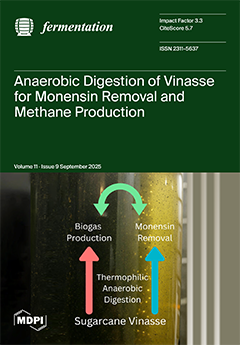2,2′,4,4′-Tetrabromodiphenyl ether (BDE-47) is a refractory organic pollutant that is characterized by its persistence, toxicity and potential for bioaccumulation. As a typical biocontrol bacteria,
Pseudomonas protegens has not been reported to degrade organic pollutants in the environment. A single strain of
Pseudomonas protegens
[...] Read more.
2,2′,4,4′-Tetrabromodiphenyl ether (BDE-47) is a refractory organic pollutant that is characterized by its persistence, toxicity and potential for bioaccumulation. As a typical biocontrol bacteria,
Pseudomonas protegens has not been reported to degrade organic pollutants in the environment. A single strain of
Pseudomonas protegens was isolated and acclimated from municipal sludge, and its ability to degrade BDE-47 was investigated. The enhancing effects of different carbon sources and inducers on
Pseudomonas protegens were also examined. Through the reinforcement of bacterial enhancers,
Pseudomonas protegens was applied to remediate soil and water contaminated with BDE-47. Based on colony characteristics, physiological and biochemical properties, and 16S rDNA gene sequence homology analysis, the strain was identified as
Pseudomonas protegens and named YP1. This marks the first discovery of
Pseudomonas protegens being capable of degrading BDE-47. Strain YP1 utilized BDE-47 as a carbon source and achieved a degradation rate of 69.57% after 75 h of incubation under conditions of 37 °C, pH 7, and constant temperature in a dark shaking incubator. After comparing the actual enhancement effects, glucose was selected as the carbon source and 2,4-dichlorophenol as the inducer to improve the environmental remediation capability of
Pseudomonas protegens. After 14 days of remediation, the degradation rates of BDE-47 in contaminated soil and water reached 48.26% and 52.60%, respectively. The
Pseudomonas protegens strain obtained from municipal sludge through screening, acclimation, and enhancement processes exhibits excellent environmental remediation capabilities and promising practical application prospects.
Full article





